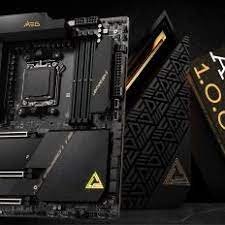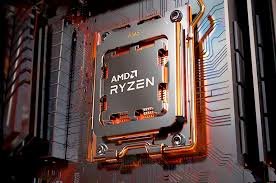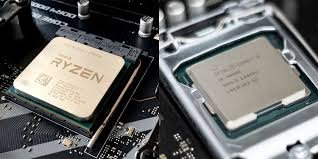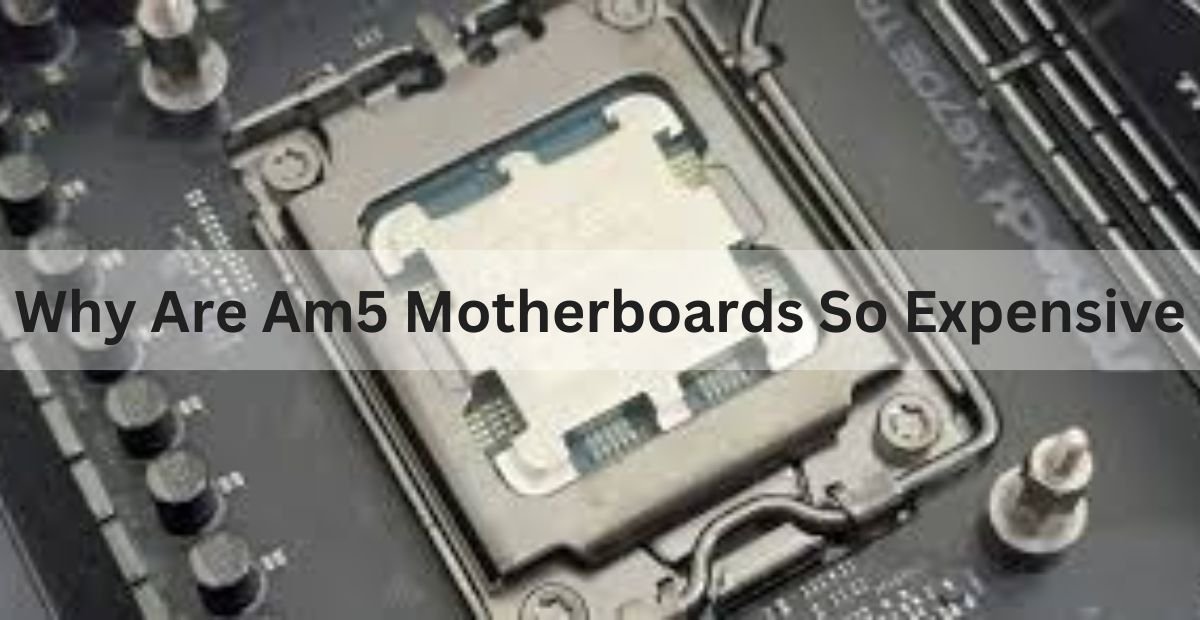AM5 motherboards represent the latest leap in motherboard technology, primarily designed to support AMD’s new generation of Ryzen processors. These motherboards are integral for unlocking the full potential of advanced CPUs, providing users with enhanced performance, improved connectivity, and future-proofing for upcoming technological advancements.
AM5 motherboards are expensive because they use new technology, support faster CPUs and memory, and have advanced features. These improvements increase their cost compared to older models.
In this article, we will discuss “Why Are Am5 Motherboards So Expensive”.
Understanding AM5 Motherboards:
1. What is an AM5 Motherboard?
An AM5 motherboard is a type of motherboard designed to support AMD’s latest CPU socket, the AM5. This socket is tailored to accommodate the newest generation of Ryzen processors, offering a host of advanced features and performance enhancements.
2. Key Features of AM5 Motherboards:
AM5 motherboards come packed with state-of-the-art features. These include support for DDR5 memory, PCIe 5.0 lanes, improved power delivery systems, and enhanced cooling solutions. These features make AM5 motherboards a powerhouse for any high-performance PC build.

Evolution of Motherboard Technology:
Motherboards have undergone significant transformations since the early days of personal computing. Initially, motherboards were simple circuit boards housing a few basic components.
Over time, they evolved to support more complex CPUs, greater memory capacities, and a variety of peripheral devices.
Key milestones include the transition from single-core to multi-core processors, the integration of advanced graphics support, and the shift from DDR to DDR4 and now DDR5 memory.
Overview of AM5 Socket:
The AM5 socket is the latest in AMD’s long line of processor sockets, succeeding the AM4 socket used by previous Ryzen processors.
The AM5 socket supports the new Ryzen 7000 series, offering features like DDR5 memory support, PCIe 5.0, and enhanced power delivery mechanisms.
This socket is critical for ensuring compatibility with the latest technologies and delivering superior performance in modern computing tasks.
Technical Specifications:
AM5 motherboards boast an impressive array of technical specifications designed to maximize performance. Key features include:
- CPU Compatibility: Designed for Ryzen 7000 series processors, ensuring top-tier performance.
- Memory Support: Supports DDR5 memory, offering higher speeds and greater bandwidth than DDR4.
- Expansion Slots: Includes PCIe 5.0 slots, providing faster data transfer rates for GPUs and other expansion cards.
- Connectivity Options: Features multiple USB ports, including USB 3.2 and USB-C, along with advanced networking options like Wi-Fi 6E and 10Gb Ethernet.
- Power Delivery: Enhanced VRM (Voltage Regulator Module) designs to ensure stable power supply to the CPU and other components.
- Cooling Solutions: Advanced cooling options, including support for liquid cooling systems and improved airflow design.
Technological Advancements:
1. Enhanced CPU Compatibility:
One of the standout aspects of AM5 motherboards is their enhanced compatibility with the latest Ryzen CPUs. These motherboards are designed to extract the maximum potential from AMD’s new processors, ensuring optimal performance and efficiency.
2. Improved Power Delivery Systems:
AM5 motherboards boast improved power delivery systems, which are crucial for maintaining stability and performance, especially when overclocking. This advancement ensures that the CPUs receive consistent and adequate power, even under heavy loads.
Read: Can Motherboards Bottleneck – The Ultimate Guide of 2024!
Manufacturing Complexity:
1. Advanced Materials and Components:
The production of AM5 motherboards involves the use of advanced materials and components, which contribute to their higher cost. These materials are not only more expensive but also require more sophisticated manufacturing processes.
2. Increased Production Costs:
The complexity of the design and the need for precision in manufacturing drive up the production costs of AM5 motherboards. This includes everything from the intricate PCB design to the integration of high-quality components.
R&D Investments:
1. Extensive Research and Development:
A significant portion of the cost of AM5 motherboards can be attributed to the extensive research and development that goes into their creation. Developing new technologies and ensuring compatibility with the latest CPUs requires considerable investment.
2. Innovations in Motherboard Technology:
The innovations incorporated into AM5 motherboards, such as advanced power delivery systems and support for new standards like DDR5 and PCIe 5.0, are the results of years of R&D. These innovations justify the higher price point.
Market Demand and Supply:
1. High Demand for Cutting-Edge Technology:
There’s a high demand for the latest and greatest technology among PC enthusiasts and gamers. AM5 motherboards, with their advanced features, are no exception. This high demand naturally drives up prices.

2. Limited Supply and Its Impact on Prices:
The supply of AM5 motherboards is often limited due to the complexities involved in their production. When supply cannot meet demand, prices are bound to increase.
Comparison with Previous Generations:
1. Differences Between AM4 and AM5 Motherboards:
Comparing AM4 and AM5 motherboards reveals significant differences. AM5 motherboards offer better performance, enhanced features, and improved compatibility with the latest hardware. These differences contribute to the higher cost.
2. Cost Analysis of AM4 vs. AM5:
While AM4 motherboards were more affordable, they also offered fewer features and lower performance compared to AM5. The additional capabilities and improvements in AM5 justify the higher price tag.
Performance Enhancements:
1. Overclocking Capabilities:
AM5 motherboards are designed with overclocking in mind. They provide robust power delivery systems and advanced cooling solutions, making it easier for users to push their CPUs to higher performance levels.
2. Better Cooling Solutions:
The enhanced cooling solutions in AM5 motherboards, including improved heatsinks and better thermal management, ensure that the components stay cool even during intense usage, contributing to overall system stability.
Benefits of AM5 Motherboards:
Despite their high cost, AM5 motherboards offer numerous benefits that justify the investment for many users. These include:
- Performance Improvements: Enhanced support for the latest Ryzen processors and DDR5 memory translates to faster and more efficient computing.
- Future-Proofing: With support for PCIe 5.0 and advanced connectivity options, AM5 motherboards are designed to stay relevant for future technological advancements.
- Enhanced Capabilities: Ideal for gaming, content creation, and other demanding applications, providing users with a superior computing experience.
Additional Features:
1. Enhanced Connectivity Options:
AM5 motherboards offer enhanced connectivity options, including more USB ports, faster Ethernet, and advanced audio solutions. These features add to their overall cost but provide greater value to users.
2. Integration of Wi-Fi 6 and Bluetooth 5.2:
The integration of Wi-Fi 6 and Bluetooth 5.2 in AM5 motherboards ensures faster and more reliable wireless connectivity. These advanced connectivity features are part of what makes these motherboards more expensive.
How long will AM5 motherboard last?
AM5 motherboards are expected to last several years, likely until 2025 or 2026. They support new AMD Ryzen processors, so you won’t need to upgrade soon. How long they last also depends on how well you take care of your PC and the demands of future technology.
Is it worth buying AM5?
Yes, it is worth buying an AM5 motherboard if you want the latest features and future-proofing for new AMD Ryzen processors. It ensures better performance and longevity for your PC.
Why are Ryzen 7000 motherboards so expensive?
Ryzen 7000 motherboards are expensive because they use the latest technology, including advanced chipsets, faster memory support, and more features like PCIe 5.0. Manufacturing costs are higher, and these boards are designed for high performance, which adds to the price.
Is AM5 dead?
No, AM5 is not dead. It is a new and active platform supporting the latest AMD Ryzen processors, offering good performance and future upgrades.
Is AM5 worth the higher price?
Yes, AM5 is worth the higher price if you want the latest features, better performance, and future-proofing for new AMD Ryzen processors. It ensures your PC stays up-to-date for longer.
AM4, AM5, or wait for new AM5 parts?
If you need a new computer now, choose AM5 for better future upgrades. AM4 is cheaper but older. If you can wait, new AM5 parts might offer more features and performance. It depends on your budget and how soon you need the upgrade.
What made motherboards so expensive?
Motherboards are expensive because of advanced technology, better materials, and more features like faster connections and better cooling.
Higher demand and supply chain issues also increase prices. Additionally, supporting new CPUs and GPUs makes motherboards more complex and costly to produce.
Why are AM5 motherboards so expensive?
AM5 motherboards are expensive because they use the latest technology, which supports faster speeds and new features.
They also have better materials and design for improved performance and cooling. High demand and production costs add to the price, making them more costly than older models.
What makes AM5 boards so expensive?
AM5 boards are expensive due to their advanced technology supporting faster CPUs and GPUs. They feature new architecture, better materials, and advanced connectivity options like PCIe 5.0.

High demand and limited supply also drive up prices. These factors combined make AM5 boards pricier compared to previous generations.
Why AMD’s Ryzen 7000 and Motherboards Cost So Damn Much?
AMD’s Ryzen 7000 CPUs and motherboards cost more due to their advanced technology and high demand. Ryzen 7000 CPUs offer significant performance improvements, driving up their price.
Motherboards supporting these CPUs are also expensive due to their advanced features like PCIe 5.0 and DDR5 RAM support, which increase manufacturing costs.
Why are current-gen motherboards so expensive?
Current-gen motherboards are expensive because they incorporate advanced technologies like PCIe 4.0/5.0 and DDR5 RAM support.
These features enhance performance but increase manufacturing costs. High demand, supply chain disruptions, and the need to support new CPUs and GPUs further contribute to their higher prices compared to older models.
Why are AM5 motherboards so expensive for gaming?
AM5 motherboards for gaming are expensive due to their support for high-performance components like powerful CPUs and GPUs.
They feature advanced technologies such as PCIe 5.0 and DDR5 RAM, which enhance gaming performance but increase manufacturing costs.
Limited availability and high demand also contribute to their higher prices compared to previous generations.
Why are DDR5 motherboards so expensive?
DDR5 motherboards are expensive because they require new technology and components to support faster memory speeds and increased bandwidth.
The manufacturing process for DDR5 motherboards is more complex, contributing to higher production costs. Additionally, the initial scarcity and high demand for DDR5 RAM further drive up prices of these motherboards.
Why are X670 motherboards so expensive?
X670 motherboards are expensive due to their advanced features like PCIe 4.0/5.0 support and DDR5 compatibility, which require newer and more costly technology.
High demand and limited supply add to their price. These motherboards cater to enthusiasts needing high-performance hardware, contributing to their higher cost.
Why are B650 motherboards so expensive?
B650 motherboards are expensive due to their support for newer CPUs and technologies like PCIe 4.0. They offer enhanced features and compatibility, increasing manufacturing costs.
High demand and limited supply further drive up prices, making B650 motherboards more costly compared to previous generations.
Most expensive AM5 motherboard?
The most expensive AM5 motherboard is typically designed for high-end gaming or professional use, featuring advanced features like PCIe 5.0 support, multiple M.2 slots, and robust power delivery.
Prices can vary, but these motherboards often exceed $300 USD due to their premium specifications and performance capabilities.
Why are motherboards so expensive?
Motherboards are expensive because they incorporate advanced technologies like PCIe slots, USB ports, and chipset features that support CPUs and other components.
The cost reflects the complexity of design, materials used, and demand-supply dynamics in the tech industry, contributing to their higher prices compared to simpler electronics.
An AMD Socket AM5 Motherboard For $125?
Yes, you can find an AMD Socket AM5 motherboard for around $125. It’s a good choice for budget gaming or building a computer. Check for sales or discounts at online stores or local shops. Make sure it has the features you need before buying.
Why are most of AMD Processors recommended for Gaming?
Most AMD processors are recommended for gaming because they offer good performance at a lower price. They have many cores and threads, which helps with multitasking and running games smoothly. AMD processors also work well with powerful graphics cards, making them great for gamers.
Will an AMD processor run all of the software that an Intel processor can?
Yes, an AMD processor can run all the same software as an Intel processor. Both use the same x86 architecture, so there is no difference in software compatibility. You can use AMD or Intel for any applications, games, or programs you need.

FAQs:
1. Why are Intel motherboards so much more expensive than AMD boards?
Intel motherboards are often more expensive because they have higher manufacturing costs, include advanced features, and use premium materials. They also support Intel’s specific technologies, adding to the price.
2. Are AMD Ryzen motherboards cheaper than Intel motherboards, given that AMD CPUs tend to be cheaper?
Yes, AMD Ryzen motherboards are generally cheaper than Intel motherboards, reflecting the lower cost of AMD CPUs and overall platform affordability.
3. Why are AMD motherboards more expensive?
AMD motherboards can be more expensive due to added features, advanced chipsets, and support for the latest technologies, making them competitive with high-end Intel boards.
4. Which is the best motherboard for AMD?
The best motherboard for AMD is the ASUS ROG Crosshair VIII Hero. It offers excellent performance, advanced features, and great build quality, making it ideal for gaming and high-end tasks.
5. Why are AMD motherboards better than Intel?
AMD motherboards are often considered better because they offer more features for the price, better compatibility with future CPUs, and strong performance for gaming and multitasking.
6. Why are some motherboards more expensive?
Some motherboards are more expensive due to advanced features like support for high-speed processors, multiple GPUs, faster RAM, better cooling solutions, and premium build quality and materials.
7. Are AMD CPUs less durable than Intel CPUs?
No, AMD CPUs are not inherently less durable than Intel CPUs. Both brands offer reliable products, and durability depends more on usage and handling than the brand of the CPU.
8. Why are AMD processors so cheap?
AMD processors can be cheaper because AMD often emphasizes value and competes aggressively on price. They use efficient manufacturing processes and focus on providing good performance for the cost.
9. Why are AMD processors so bad comparing to Intel ones?
AMD processors aren’t necessarily bad compared to Intel. They offer competitive performance and value in different ways, like multitasking and gaming, while Intel focuses on single-threaded performance and specific applications.
10. Is there any problem with AMD processors?
No, AMD processors generally work well. Occasionally, there may be compatibility issues with software or hardware, but AMD regularly updates drivers to fix such problems.
Conclusion:
In conclusion, AM5 motherboards are expensive due to their advanced technology supporting faster CPUs and memory, enhanced features like PCIe 5.0, and high manufacturing costs. They represent AMD’s latest innovation for powerful computing, ideal for gaming and demanding tasks, ensuring compatibility with future upgrades and delivering superior performance.
